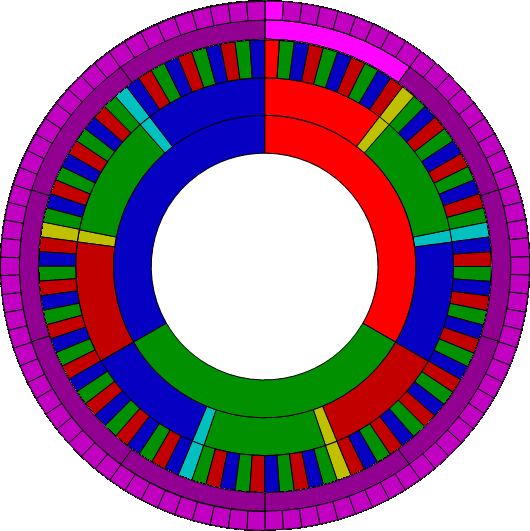Time and the Cycle
Time is measured in the Dominion using the clock, for divisions within a Cycle and the Calendar for counting Cycles.
The definition of a Cycle is 86,400 seconds and its use pre-dates Founding.
The Dominion Clock
Units
The base unit is called a second. It will be familiar to players and is identical to the contemporary measure.
The following units are derived from a second (player time shown in parentheses):
90 seconds = 1 moment (1.5 minutes)
10 moments = 1 task (15 minutes)
10 tasks = 1 job (2.5 hours)
3 jobs, broken by 2 breaks each of 1 task in length = 1 shift (8 hours)
3 shifts = 1 cycle = 86400 seconds (1 day)
Standard Clock
The Dominion Clock is constructed to represent these divisions, longer divisions are in the middle with shorter divisions on the outside.
The colours are generally used to name the shifts, and numbers are generally used to name the shorter units. The breaks are called ‘Yellow’ and ‘Teal’ or ‘First’ and ‘Second’.
For example, the clock below is showing:
- Red Shift, Red Job, Task 1, Moment 1 and 1 second.
In common notation this would be written as RR01-1-01. (Yes, when people talk about time they use numbers, but when they write it they use letters representing colours.)

Local Time
On worlds within the dominion, local clocks may also have an inner ring of black and white showing how local planetary rotation and the day-night cycle interacts with Dominion time.
Time Zones
The Dominion has no time zones as such – there is uniform Dominion time based on the Dominion clock and overseen by the Vizierate by which people organise their lives, and there is local time based on local planetary rotations by which people figure out if it will be day or night when they go outside.
The Dominion Calendar
Time is organised in multiples of 10, starting with the zero (unlike the Clock, which doesn’t have zeroes.)
- 10 cycles (ending in digits 0 to 9) = 1 dekaCycle
- 10 dekaCycles = 1 hectoCycle = 100 Cycles [~= 3.5 months (what are these ‘months’ you speak of? Strange word, doesn’t even rhyme with anything!)]
- 10 hectoCycles = 1 kiloCycle = 1000 Cycles [~= 2 years 9months]
- 10 kiloCycles = 1 myriaCycle (10000 Cycles) [~= 27 years 5months]
Most people who work get 3 cycles off out of every 10, but which cycles vary.
Contemporary Comparisons
By comparison with the contemporary Gregorian calendar, a Cycle is a Day, and has the same length.
The dekaCycle is used as the equivalent of the week.
Names of Cycles are, imaginatively, 0-Cycle, 1-Cycle, 2-Cycle, 3-Cycle, 4-Cycle, 5-Cycle, 6-Cycle, 7-Cycle, 8-Cycle and 9-Cycle.
For practical purposes, a Month is a convenient measure of time, and the Dominion uses a period of 30 Cycles (3 dekaCycles) for many things, but there is no formal name for it; terms like ’30 Cycles’ or ’30 Cyclic’ or ‘three-deka’s’ are used.
The hectoCycle is used as the equivalent of an annual quarter or a school term.
Similarly to a contemporary month, a period of 3 hectoCycles may be used when a duration of about a year is needed, and ‘three-hecto’s’ has applications in agriculture and animal husbandry.
Common Usage
The word ‘year’ is commonly understood to mean ‘the period of the orbit of a planet about its star’.
The word ‘day’ is sometimes used to mean the period of rotation of a planet about its axis, but this is commonly referred to as a ‘spin’ or ‘rotation’. The term day has mostly devolved to mean ‘it’s light outside’.
Anyone involved in agriculture, husbandry or affected by seasonal variation will usually have a local calendar in common use rather than the Dominion standard.
One social impact of this is that anniversaries, such as of birth etc are usually celebrated on the kiloCycle. When you ask people their age, they will usually answer in kilocycles.
For example:
- Most civilians live to about age 24 (kilocycles) and people in the enclaves to about 3 myriaCycles (30 kilocycles).
- The age of majority is 7.
- People generally have their mid-life crisis at 15.
Dates are often written as a decimal expressed in kiloCycles, eg 7.815 kCy = 7 kilocycles, 8 hectocycles, 1 dekacycle, 5 cycles.
